Amount of energy transferred from one trophic level to next is
90%
10%
50%
1%
The correct Answer is:B
Amount of energy transferred from one trophic level to next is 10%
Topper's Solved these Questions
- ECOSYSTEMBook:A2ZChapter:ECOSYSTEMExercise:Section C: (PREVIOUS YEARS' EXAMINATION QUESTIONS) AIIMS Questions
Explore 11 Videos
- ECOSYSTEMBook:A2ZChapter:ECOSYSTEMExercise:Section C: (PREVIOUS YEARS' EXAMINATION QUESTIONS) Assertion and reason type questions
Explore 6 Videos
- ECOSYSTEMBook:A2ZChapter:ECOSYSTEMExercise:Section B: Assertion-reasoning Questions
Explore 23 Videos
- BIOTECHNOLOGY: PRINCIPLES AND PROCESSESBook:A2ZChapter:BIOTECHNOLOGY: PRINCIPLES AND PROCESSESExercise:Section D: Chapter-end Test
Explore 50 Videos
- ENVIRONMENTAL ISSUESBook:A2ZChapter:ENVIRONMENTAL ISSUESExercise:Section D : Chapter-end Test
Explore 50 Videos
Similar Questions
Food chains and the energy flow within an ecosystem provide an important understanding of contingencies and mutual dependencies of organisms. The given below flow chart depicts the energy flow within some members of a grassland ecosystem. The grass in the below ecosystem transducer 120,000 J of sunlight and fixes it into 12,000 J of energy. It is established that 90% of the energy of one trophic level is not passed to the next trophic level. Further assume that the energy transferred from one trophic level to the next is equally shared among the different organisms at that trophic level.
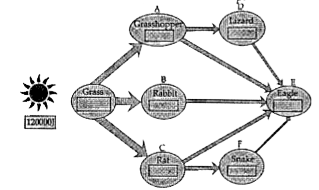
Based on the above information, indicate the amount of energy that an organism C may have received from an organism from the previous trophic level.
View SolutionFood chains and the energy flow within an ecosystem provide an important understanding of contingencies and mutual dependencies of organisms. The given below flow chart depicts the energy flow within some members of a grassland ecosystem. The grass in the below ecosystem transducer 120,000 J of sunlight and fixes it into 12,000 J of energy. It is established that 90% of the energy of one trophic level is not passed to the next trophic level. Further assume that the energy transferred from one trophic level to the next is equally shared among the different organisms at that trophic level.
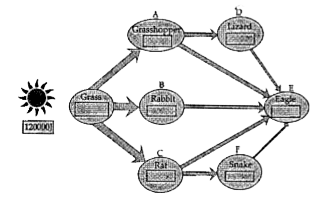
Tropic levels are formed by which of the following components?
View Solution
Knowledge Check
Amount of energy transfered from one trophic level to next is
A1.5%B10%C15%D20%Energy transferred from one trophic level to another is
A0.05B0.1C0.15D0.2Energy transferred from one trophic level to another is
A0.2B0.1C0.15D0.05
Food chains and the energy flow within an ecosystem provide an important understanding of contingencies and mutual dependencies of organisms. The given below flow chart depicts the energy flow within some members of a grassland ecosystem. The grass in the below ecosystem transducer 120,000 J of sunlight and fixes it into 12,000 J of energy. It is established that 90% of the energy of one trophic level is not passed to the next trophic level. Further assume that the energy transferred from one trophic level to the next is equally shared among the different organisms at that trophic level.
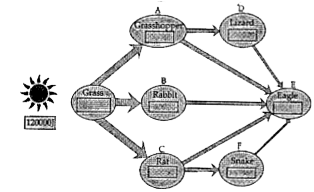
In the food web depicted above, identify the most energy efficient link for tertiary consumer.
View SolutionFood chains and the energy flow within an ecosystem provide an important understanding of contingencies and mutual dependencies of organisms. The given below flow chart depicts the energy flow within some members of a grassland ecosystem. The grass in the below ecosystem transducer 120,000 J of sunlight and fixes it into 12,000 J of energy. It is established that 90% of the energy of one trophic level is not passed to the next trophic level. Further assume that the energy transferred from one trophic level to the next is equally shared among the different organisms at that trophic level.
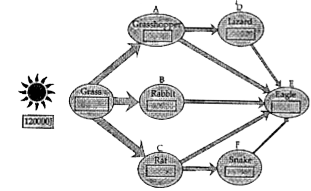
How many food chains are present in the food web depicted above?
View SolutionFood chains and the energy flow within an ecosystem provide an important understanding of contingencies and mutual dependencies of organisms. The given below flow chart depicts the energy flow within some members of a grassland ecosystem. The grass in the below ecosystem transducer 120,000 J of sunlight and fixes it into 12,000 J of energy. It is established that 90% of the energy of one trophic level is not passed to the next trophic level. Further assume that the energy transferred from one trophic level to the next is equally shared among the different organisms at that trophic level.
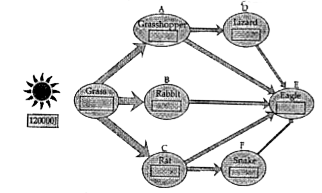
Which organism acts as both the secondary consumer and the tertiary consumer?
View SolutionRead the given passage and answer the following questions :
Food chains and the energy flow within an ecosystem provide an important understanding of contingencies and mutual dependencies of organisms. The flow chart given below, depicts the energy flow within some members of a grassland ecosystem. The grass in the below ecosystem transduces 120,000 J of sunlight and fixes it into 12,000 J of energy. It is established that 90% of the energy of one trophic level is not passed to the next trophic level. Further assume that the energy transferred from one trophic level to the next is equally shared among the different organisms at that trophic level. Based on the information given and your knowledge, answer the following questions.
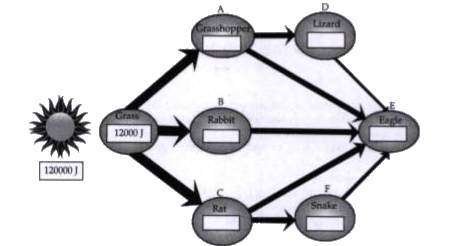
The first trophic level in a food chain is always a green plant. Why?
View SolutionA food chain depicts the flow of energy from one trophic level to another. Which of the following represents the percentage of energy transfer from one trophic level to the next?
View Solution

